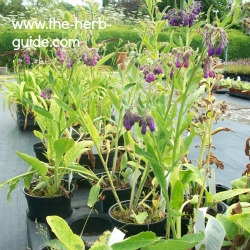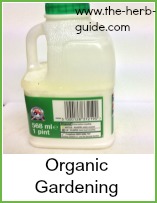- The Herb Guide Home
- Growing Herbs
- Growing Comfrey
Comfrey
As an Amazon Associate I earn from qualifying purchases

You can try a sample lesson to help you decide if the Herbal Academy of New England is the right choice for you - follow the link below.
As a natural fertilizer, comfrey contains all the nutrients you need for healthy plant growth.
It is high in potash, nitrogen, phosphorous and many other elements.
You can use it as a mulch - just spread the leaves around the base of your plants where they will break down - or line the bottom of planting holes with them.
Add the leaves to your compost heap where it will work as an activator to encourage other plant material to break down.
You can make a liquid fertiliser (herb tea) by filling a bucket half full with leaves, then fill it with cold water.
Put a lid on the bucket to exclude insects and leave for about 4 weeks.
Strain off the liquid and use it as an organic fertilizer for plants, tomatoes and other garden plants.
Put the wet leaves on the soil around your vegetables, making sure that they don't touch the leaves. They will rot down and the goodness will go into the soil.
You will need to water the tea down as it will be quite strong. Use it one part solution to four parts water in a can to water your plants round the roots - if you pour it directly on to the plants, they may burn.
It is well worth cultivating a patch - it has very strong tap roots and is considered to be invasive, like horseradish. On the plus side, it doesn't set a lot of seeds.
It's a perennial plant which you can buy either as a growing plant or sow seeds.
You can increase your stock if you need to by division - you merely dig up the whole thing and tease the roots apart - it is quite easy but be gentle and work very slowly, being careful not to break the roots if possible.
Trim the top growth back and replant. Keep well watered until the plantlets are established - it's had a bit of a shock, so treat them with tender loving care.
Add the trimmings to your compost heap or your fertilizer pot or just put it on your flower beds to rot down and feed the soil
Medicinal Uses of Comfrey
Herb Tips
Comfrey has been used since the Middle Ages as a healing agent for fractures. It is commonly known as 'Knitbone'.
I'm not suggesting that you use it instead of seeing a doctor - if you've broken your leg, this won't help, you're going to need medical intervention!
BUT it has a substance called 'allantoin' which promotes healing of bone and body tissue and is useful for applying to bruises, varicose veins and sprained muscles.
For external use, make it into a poultice -just warm whole leaves in boiling water, allow it to cool slightly and then place on the affected area.
You can also make a poultice from the grated root. If you use the leaves as fertilizer, dig up and dry off the root. Store in jars in a cool dark place until you need it.
Where would you like to go next?
I may receive a commission if you purchase something mentioned in this post. See more details here This will not affect the amount you pay.





